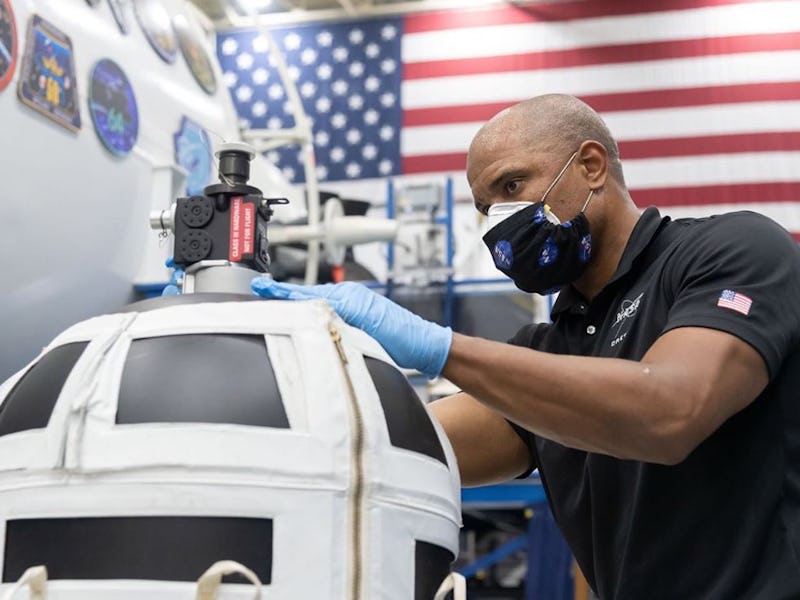SpaceX Crew Dragon: NASA images show biggest launch yet is almost here
SpaceX and NASA have been working together to develop a means to transport humans to and from the International Space Station.

SpaceX's Crew Dragon, the human-carrying capsule, is about to take on its biggest ever mission.
On Thursday, NASA's Johnson Space Center shared four photos on Instagram of the next team set to launch with the Crew Dragon. The images show the four astronauts, set to launch on the "Crew-1" mission, getting to grips with the International Space Station's systems.
It's set to be a major test for SpaceX's capsule, after it successfully completed its first crewed mission on May 30. NASA astronauts Bob Behnken and Doug Hurley flew on the "Demo-2" mission, which demonstrated the capsule is suitable for sending humans into space. The mission's success paves the way for a new era at NASA, where the agency relies on private companies to ferry its crew to and from the space station.
Soichi Noguchi, Shannon Walker and Michael Hopkins.
The "Crew-1" mission will be the capsule's first non-test mission, and it will be the first time the Crew Dragon has flown with every seat occupied. Although the Crew Dragon was originally designed to support up to seven seats, the capsules NASA uses only offer four seats. In December 2019, SpaceX president Gwynne Shotwell told SpaceflightNow that NASA wanted to change the angle of the seats due to concerns about the g-force astronauts would experience when returning to Earth. That meant three seats had to go.
Michael Hopkins, Soichi Noguchi and Victor Glover Jr.
Flying on this momentous mission is:
- Shannon Walker, a Texas native that was selected to be a NASA astronaut in 2004.
- Michael Hopkins, a Missouri native who was chosen to be a NASA astronaut in 2009.
- Victor Glover, Jr., a California native who was selected as a NASA astronaut in 2013.
- Soichi Noguchi, an astronaut with Japanese agency JAXA. A Kanagawa native, Noguchi was selected to be an astronaut in 1996 by JAXA's predecessor agency NASDA.
Victor Glover Jr.
At the space station, the teams have been preparing for the "Crew-1" mission. On Wednesday, NASA shared that four of the five members of the ongoing Expedition 63 took part in a one-hour habitability test. This used the capsule docked with the space station that sent up Behnken and Hurley, rearranging it and reporting the comfort levels when the capsule holds four people. Hurley and Behnken were joined by station commander Chris Cassidy and Roscosmos flight engineer Anatoly Ivanishin.
Soichi Noguchi, Shannon Walker and Victor Glover Jr.
Timing for the launch is as yet unclear. One of the major factors will be when Behnken and Hurley return to Earth. That could be as early as August 2, according to NASA last week. The agency has previously explained that it needs around six weeks between the pair returning and the "Crew-1" team launching.
The "Crew-1" mission is expected to fly in a new Crew Dragon capsule, rather than reusing an old one. NASA cleared the way last month for astronauts to fly on reused capsules and rockets, expected to start with the third crewed flight sometime next year. Reusing rockets is a key aspect of SpaceX's business model, which can help it to save $46.5 million from the $62 million price tag associated with a Falcon 9 launch.
The Inverse analysis – This mission will help solidify NASA's new approach to astronaut launches, transforming the Crew Dragon launches from groundbreaking achievements to almost everyday events. It's a similar trend to SpaceX's Falcon 9 launches, or even its Falcon 9 landings. As both have been perfected over time, they've become almost expected occurrences.
NASA's new approach to astronaut launches will receive a boost as Boeing completes work on its CST-100 Starliner. This week it emerged that the project may have been delayed due to reduced scrutiny from NASA. When it launches, the agency will have two companies it can work with to launch astronauts as it works toward more ambitious projects like Artemis.